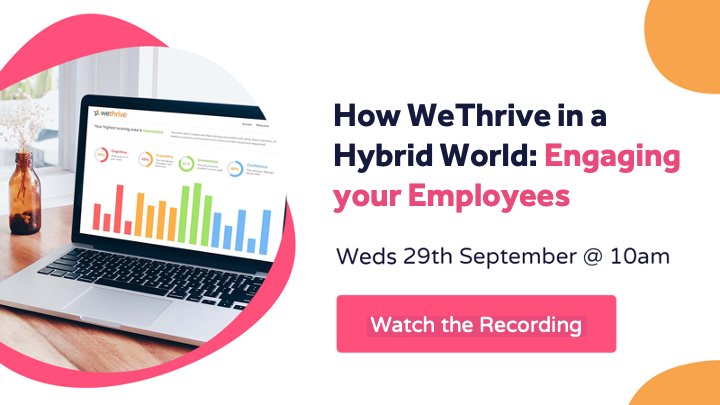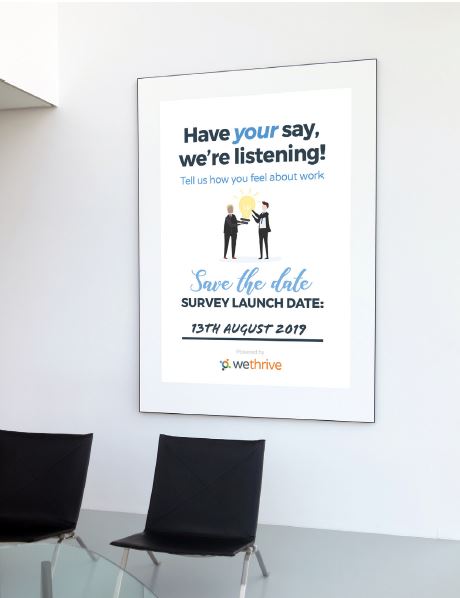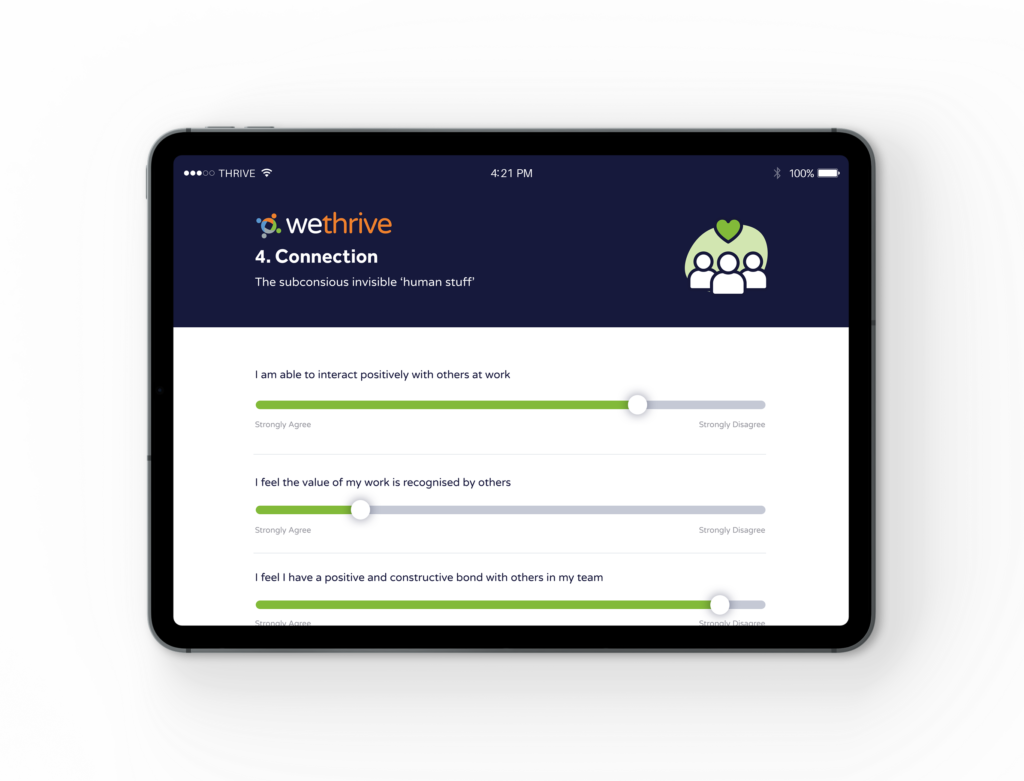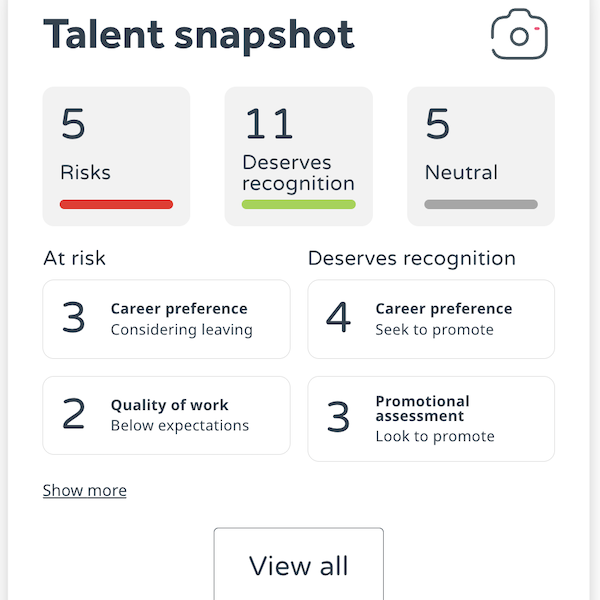 Do you want to improve the way your organisation plans, implements and acts on the results of employee engagement surveys? Or, perhaps you are facing this task for the first time? This guide is designed to steer you the process of staff engagement surveys, from start to finish (although, as it’s a reiterative process, there is no finish, but more on that later).
Do you want to improve the way your organisation plans, implements and acts on the results of employee engagement surveys? Or, perhaps you are facing this task for the first time? This guide is designed to steer you the process of staff engagement surveys, from start to finish (although, as it’s a reiterative process, there is no finish, but more on that later).
Contents
Chapter one – employee engagement
Chapter two – how to run a successful employee engagement survey
Chapter three – how technology supports employee engagement surveys
Chapter one – employee engagement
What is an employee engagement survey?
Employee engagement is essentially the extent to which employees are passionate about their jobs. It is based on the premise that happy employees are emotionally engaged with their work, are committed to the vision and values of the business and are more productive.
No matter where you are or what size your business, having engaged employees matters. Multiple studies have shown that motivation, productivity and retention are all impacted by how engaged your employees are. However, according to research by Gallup, a whopping 85% of employees worldwide are not engaged in their jobs.
If you’re not providing the opportunity for staff to be listened to and the employee experience improved, you also run the risk of employees leaving, increased sick days and people voicing their grievances on social media or review sites like Glassdoor, which can negatively impact your business.
The challenge with employee engagement
According to the latest research from Deloitte their ‘The Worker-Employer Relationship Disrupted’ states that 68% of executives agreed that workforce strategies will be more customised in the future to individual needs, so more than ever it is clear that organisations must have a clear strategy and company goals in place to truly invest in their people.
But uncertainty around what employee engagement is, and how to ensure everyone’s individual needs are met accounts for the difficulty many company boards have had in understanding its importance – if you don’t know exactly what you are supposed to be measuring, how can you be sure you are improving it, let alone be certain that it will have a positive impact on the bottom line?
Benefits to business of an engaged workforce
Creating an engaged and thriving company culture delivers significant bottom line benefits and there is plenty of qualitative data and quantitative evidence to prove it.
According to Deloitte’s research in ‘Engaging the Workforce‘ report, organisations with highly engaged employees experience a 3-year revenue growth rate 2.3 times greater than average. These results are significant, and the impact on productivity and profitability cannot be overstated. McKinsey’s 2021 ‘Shaping the ‘New Possible’ through Employee Experience‘ research echoes these findings, stating “employees at leading EX companies are more inclined to surpass work expectations, having a 40% higher level of discretionary effort.”
Furthermore, while many businesses are fighting to retain key players during the ‘Great Resignation’, organisations with engaged workers are 87% less likely to leave (Deloitte).
Business outcomes
With an increasing labour turnover, particularly in some of their newer members, and a remote team that wasn’t easily accessible, the Personal Group wanted to understand how staff were feeling and what improvements could be made. With the introduction of a new approach to employee engagement, they realised many benefits and most notably, staff retention increased by 19%.
For Harwoods, a privately owned automotive retail group with over 900 employees, their employee engagement survey revealed new insight that led to the business saving 360 days of senior management’ time saved across multiple retail sites.
“We wanted to start by listening to what our employees had to say. Having just completed our first company wide WeThrive survey, the results were fascinating. As a management team we are seeing the benefits, but more importantly, so are the wider team.”
Archie Harwood,
CEO
What are the characteristics of an engaged workforce?
Engagement at work ultimately reflects how much people want to be there, and this depends on how successfully work meets their biological, psychological and social needs.
The characteristics shown below, more than any perk, piece together to create the ultimate working environment where people will engage, thrive and want to stay.
- Clear vision
- Defined company goals
- Strong cooperation and communication between teams
- Suitable skills
- Adequate resources
- Positive social environment
An initiative gaining pace and contributing to employee happiness is the introduction of the 4 day working week. But, shortening working time has to stem from a company mission for employees to have a great work-life balance and trusting that people can be more productive if their work style fits with their personal life.
Employee engagement matters now more than ever
Over 8 million people in the UK are suffering from a ‘second pandemic’ of mental health issues. National levels of depression have doubled since the beginning of Covid and many of these people are suffering but still at work.
In 2020/21 stress, depression or anxiety accounted for 50% of all work-related ill health cases, nearly double that of the previous year. (HSE)
It is very worthwhile for every company to seek out the causes of stress in the workplace and do whatever is practical to reduce them. Reduced stress leads directly to less sickness – and also to better motivation, performance, collaboration and staff retention.
If businesses are serious about retaining their most productive, experienced and capable employees, they must invest in employee engagement.
“To better support employees’ mental health at work employers need to create a genuine, sustainable culture through good communication and actions. It’s not about putting notices on boards or in the toilets, it’s about understanding people, giving them a voice perhaps through a survey like WeThrive offer and then acting on the results.”
Ian Braid, MD, Dociasport, Duty of Care In Action & mental health campaigner
Watch our popular webinar “How WeThrive in a Hybrid World” where Andrew Heath discusses the importance of employee engagement, how to engage your hybrid workforce and gives a briefing and product demonstration.
Chapter 2 – How to run a successful employee engagement survey
The 8-step employee engagement survey process
1. Plan
The first question has to be: what is the problem we are trying to solve? If everything in the organisation is perfect you can stop right here and go to lunch, but that would be unusual. So is it employee churn, sickness rates or productivity? Are there problems with poor communication, silos or counter-productive competition between people or departments?
Additionally, there are usually issues with the way people are managed. It’s been said that many people are promoted to management positions because they were good at something else, and we know that many managers really don’t have time or aptitude for people management. These managers benefit greatly from being given a focus for their interactions with their teams, a starting point for the conversations they need to hold and some backup materials to help them hold these conversations better.
Common workplace issues
- Employee churn
- High sickness rates
- Low productivity
- Poor communication
- Working in silos
- Counter-productive competition between people or departments
Whatever your issue(s), a survey will potentially give you a lot of hugely useful information, if you ask the right questions and are able to analyse what answers come from where.
So start by writing down what matters, by as many segments as could be useful: all the departments, teams, locations or whatever other units your organisation uses. This segmentation of the people data will be invaluable later on, when the time comes to do something useful with the results.
It also raises the possibility of helping individual managers, especially the more reluctant ones, to improve the way they do that part of their job, with benefits for their teams, the organisation and, not least, for themselves.
Staff data
If you don’t already have it, you need to develop a single, easily accessible list of employees, broken down by all the variables that might be important when it comes to using the survey data.
Here are some suggestions of what data to gather for each staff member:
- Gender
- Tenure
- Employment status
- Age
- Generational bracket
- Their team
- Location
- Unit
- Department
- Name of manager
It may not be appropriate to collect all of this staff data, but it really is worth making sure you have robust data that you can analyse in any way you need.
2. Survey questions
If you use an external provider to run your survey they will have a preferred question set of their own.
Think carefully about the actual questions before deciding on a survey provider. Questions traditionally used in an employee satisfaction survey such as ‘can I see myself working here in 5 years time‘ have very little value these days.
Questions about the workplace environment, work structures and processes are obviously important, but we now have so much of a clear understanding about what actually motivates people and it is questions built around these ideas that generate the real insights into staff behaviour.
That’s why WeThrive uses a question set built around our own psychological 4C Employee Engagement Model. Developed by business psychologist and WeThrive co-founder Piers Bishop, the 4C Model is built around scientifically established principles of the Human Givens Institute and looks at how human needs are met in a workplace context. As well as enhanced insights, WeThrive’s software also generates action plans with recommendations built around the 4C model, so that the outcome of the survey is real change, not just numbers.
Like most things, with so much information and free resources at our disposal online, it is easy to think the employee questionnaire design can be done in-house, but there are many significant reasons why it could be a bad idea to DIY your employee engagement survey.
Read more > Employee engagement survey design: six critical considerations
3. Introduce the survey
The first rule of change is to encourage positive employee attitudes to the survey by making it worth people’s while. Before anyone is sent an employee survey link it is vital that the whole survey exercise is carefully framed for the staff, and that they can see they will be better off for taking part.
4. Launch
Let employees know it’s important they take part and share their views. The more people participate, the more representative the results and the more impact they can have.
5. Reminders
Remind staff regularly to take part and thank those who already have. A good piece of survey software will have the facility to remind staff periodically, and to thank them for taking part. But it is so much better if the whole organisation feels involved in the survey process.
Every manager should tell their team when they have filled in their survey, for a start, and some organisations appoint survey ‘champions’ who circulate among the staff being upbeat and positive while reminding staff that this not a random bureaucratic exercise but a step towards better working conditions.
This is an opportunity to exercise your creativity! Use posters, instant messaging and company update meetings and why not have an extra-delicious treat in the kitchen as a thank-you for contributing to the survey?
6. Say thank you
Work relationships thrive on acknowledging each others inputs. Thank your staff as soon as possible after the survey has closed and offer them some headline news. Staff may not consciously be expecting a ‘thank-you’ for taking part in the survey, but they will certainly feel more positive about the whole exercise if they receive one as soon as possible after they fill it in.
Read more > Employee engagement survey communication strategy
7. Act fast
Ideally, every employee, manager, HR, director or training & development department or other change agent will have appropriate access to the survey information as soon as it closes. Time spent crunching data from the survey results is time that should be spent getting to grips with the issues that need resolving, so you really need a system that does it for you, immediately and automatically.
Of course you will need to spend time considering the employee feedback and prioritising actions, but the sooner your managers get on with talking to their teams, and employees looking at their feedback, the sooner the identified stresses can be, where practicable, relieved. Start the conversations while the survey exercise is still in people’s minds – this way they will connect the survey with the subsequent work to improve their job satisfaction, and again this will improve the amount and quality of survey responses next time round.
8. Track progress
However you survey your staff and formulate action plans, be sure to have a system for tracking what happens next.
If you want something to happen, it’s extremely useful to agree on specifics rather than a general plan or aim. So, when discussing action plans be sure to agree on a number of things, in plain terms:
- Who is going to do what, where, and with what materials?
- How are they going to do it, and by when?
- How will you help them know why they are doing it?
- How will everyone know if it is complete, or if more needs doing
Nothing stays the same. Even if you do all the possible improvement work so that everyone in the company feels absolutely wonderful about every aspect of working life, something will come along to spoil this 100% perfection. People leave, new ones arrive, circumstances change, the economy fluctuates and customers’ expectations change.
Employee engagement survey best practice
Survey anonymity
In The End of Average, Todd Rose explores just how many ways there are for the average person to differ from average – and it turns out that no-one in the entire population is average in every way. The average pupil and the average patient simply don’t exist, and neither does the average worker. No-one fits a one-size fits all solution.
“All we’ve got as humans is our difference. So, the only way we ‘fit’ together is by recognising that and loving it.”
Simon Fanshawe, Stonewall founder and diversity champion
A commonly held view is that employee engagement surveys should be anonymous, largely because it is assumed that people will not speak freely otherwise. However, recent research shows that is not the case – gathering feedback using attributable surveys gets better, more comprehensive data from more willing employees if they are not anonymised.
5 proven reasons to run an individual (not anonymous) employee engagement survey
- Higher engagement levels and response rates
- It makes the survey more representative
- It actually tells you what is going on, and what to do about it
- It makes the company responsible for responding positively and quickly
- It generates commitment to change from employees
“Using a non-anonymous survey was revelatory. Anonymity results in a blended mish-mash of data and can only take you so far with understanding how people really feel. With individual insights you get absolute clarity about what is really happening and can pinpoint individual needs. This means the line manager can take ownership and really address each individuals requirements.”
David Blackburn,
CPO, FSCS
Read more > Should an employee engagement survey be anonymous?
How often should you survey?
Once a year – This is not really enough now; people have become used to having their consumer opinions sought for reviews by businesses so constant feedback gathering has become much more commonplace.
Employee pulse survey – A criticism of pulse surveys is that they’re run too often and are over too quickly for any employee benefit to be associated with the survey.
Two-four times a year – in between these two extremes, running an employee engagement survey two to four times a year will allow time for each part of the continuous learning cycle: measure, learn, change, settle, repeat.
Whenever your employee feels they need support – self assessment employee engagement surveys are crucial in the modern hybrid world. It allows employees to get instant, direct, and personal feedback to help them address their individual needs.
Repeating the process on a regular basis means you can measure the fluctuations in engagement following the changes you make as a result.
The length of this learning cycle may vary with the kind of organisation, the age of the staff and the seasonal demands in the business.
Another option is to fix one point in each year where you can run a full staff engagement survey to use as a benchmark, and then use your survey tool tactically as needed. For example, when a team is new or underperforming or a big project starts that involves a number of teams.
The key is that real change needs to happen if the goal of the survey truly is to improve employee engagement. This also means repeating the entire process on a regular basis so you can measure the fluctuations in engagement following the changes you make as a result.
Read more > how often should you conduct an employee engagement survey?
Chapter 3 – How technology supports employee engagement surveys
Traditional employee surveys were, frankly, a bit of a blunt instrument. An average score for a division, or even a single team, may tell you something about the top-level priorities for that group, but it says almost nothing about how each individual employee feels.
Employee engagement software can make a huge difference to the outcome of an employee survey. You can request feedback from employees at specified frequencies, analyse results, and set goals for improving employee engagement.
Many platforms offer a host of features. Most are cloud-based SaaS (software as a service), commanding a monthly subscription charge, which is great because it means companies can spread the cost, without any heavy initial outlay.
Key benefits of using employee engagement software:
- Insight available immediately – no waiting time whilst someone churns through the results.
- More than employee engagement data – We Thrive’s employee engagement software, for example, doesn’t only ask the right questions to get to the root cause of employee unhappiness, it offers actionable insights on engagement problems and enables you to track post-survey activities.
- Reports and dashboards – all the data processing is done for you and presented in a way that’s easy to understand and share with your senior leadership team / colleagues.
- Mobile – most employee engagement platforms offer mobile applications enabling employees to complete surveys on the go.
“We’ve been conducting engagement surveys with our team for many years and have learnt much from the experience. I would have to say that the WeThrive survey is the best we’ve come across because it’s simple to complete for our team and so easy to analyse and then create real-world actions to improve. The analysis session we held with Lauren at WeThrive also really helped us to accurately understand the feedback so that we focus in on the right areas for improvement. I would recommend the system to any company wanting to better understand and improve their levels of engagement.”
Sam Bernard,
Director, DBD Distribution
If you’re unsure about which employee engagement software is right for you, then why not try the survey to see how the survey works, and what the action recommendations can tell you.
About WeThrive
WeThrive is the only employee engagement software that tells you specifically what to do next, and can guarantee at least a 10% improve engagement, wellbeing or retention in the first 12 months – or your money back. Our surveys uncover how your people truly feel, creating more engaged, happy and productive employees, retain key staff for longer and deliver better business results.
At organisation, team or individual level WeThive’s unique 4C model leverages the latest psychological understanding to quickly and easily deliver insights, actions and learning content to help your managers become better managers, creating a high performance culture and improving business results. UK based, WeThrive has an average 91% survey, 1000+ action recommendations and 350+ learning resources.
Get started today with a free account for 10 people at your business.









